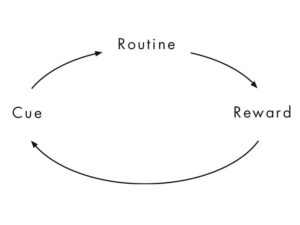
There’s an often-quoted, always mis-attributed aphorism that goes, “If you always do what you’ve always done, you will always get what you’ve always got.”
It points to the fact that if you want to get different results, you have to change your activities. If you want to different outputs, you need different inputs.
Sounds simple, right?
But if it’s simply a matter of different inputs, then why do many of us consistently fail to change our sales results?
It’s because at the beginning of each new year, each new quarter, and each new sales contest, salespeople sit down and promise themselves (and their sales managers) that it’s going to be different.
But their activities don’t really change. Their habits, the ones they’ve had for a long time, reassert themselves. And by two weeks later, it’s the same old story.
So if you want to really change your sales results, you have to dive in and rewire the habits that are driving your activities.
Why Your Sales Resolutions Fail
Selling is a very transparent gig. You can’t hide your performance. And the results that you get are the direct results of your activities.
More often than not, those activities that drive our results are habitual. They’re behaviors that we engage in without a lot of conscious thought or planning. It would be exhausting for us to make hundreds of decisions a day, so our brain has an auto-pilot that does most of the work for us. And those unconscious decisions aren’t always creating the results that we want.
 In The Power of Habit, Charles Duhigg outlines the habit cycle of Cue –> Routine –> Reward. It’s a useful model for looking at the way that habits shape our day. And it’s a lens that salespeople can use to look at how their habits are driving their daily activity.
In The Power of Habit, Charles Duhigg outlines the habit cycle of Cue –> Routine –> Reward. It’s a useful model for looking at the way that habits shape our day. And it’s a lens that salespeople can use to look at how their habits are driving their daily activity.
When you run into different Cues, whether it’s your drive to the office or sitting down to schedule appointments, most of what you do is on autopilot. We have an automatic routine when we’re in a situation that we’ve already been in before. It’s why you can daydream on your morning commute (or during those appointment-setting sessions).
This also highlights why it’s so hard to change our selling behaviors. Much of what you’re doing every day is an unconscious process, you aren’t doing it on purpose.
And it’s really hard, if not impossible, to get rid of our habits. They run deep in our brains and you can’t just stop them.
Redirect Your Micro-Habits
 What you can do, Duhigg posits, is change the Routine that gets triggered by a Cue. That’s how you alter a habit. You re-route it to create a different behavior.
What you can do, Duhigg posits, is change the Routine that gets triggered by a Cue. That’s how you alter a habit. You re-route it to create a different behavior.
For example, instead of eating a cookie when you get bored in the afternoon, you could go for a 5-minute walk around the office. In that way, you aren’t trying to dam the river, you are just diverting the path that it takes
Or in your case, you could focus on changing the knee-jerk reactions that you have to different cues during your regular sales activities.
There are many small behaviors that drive success in a sales role. If you try to change all of them at once, you’ll often burn out and give up too early. But by focusing on one or two inflection points, you can change how you react in those moments.
Create a Day of Useful Sales Habits
 For example, what is your habit around getting a win on the phone? What do you do when you set an appointment or get a customer commitment? Does it look like this:
For example, what is your habit around getting a win on the phone? What do you do when you set an appointment or get a customer commitment? Does it look like this:
Schedule a sales demo (CUE) –> Celebrate and tell your team and sales manager (ROUTINE) –> Bask in the endorphins (REWARD)
You do this even though the best time to get a win is right after you’ve already had one. So what if you change the habit?
Schedule a sales demo (CUE) –> Call 5 more prospects as fast as possible (ROUTINE) –> Bask in the endorphins (REWARD)
Or worse, does your response to rejection look like this:
Hear a “no” from a prospective customer (CUE) –> Mope around, complain to a colleague, and surf Facebook (ROUTINE) –> Not face another chance for rejection (REWARD)
What if you changed that routine to one that involved make more attempts right away? Whatever your responses, it’s important to wrap your head around the fact that they are unthinking reactions. You don’t do them on purpose. If you try to consciously make all of these decisions every day, you’re going to burn out.
Change One Habit at a Time
The best path forward is to look at one habit at a time. It’s hard to intentionally look at every decision you make in a day, but you can focus on specific scenarios.
In fact, there are lots of small cues that populate your day:
 You first get out of bed
You first get out of bed- You sit down at your desk to start the day
- A prospect says yes or no on the phone
- You get a sale or you don’t get a sale
- You have a no-show or an appointment cancellation
- Your sales manager gives you feedback
- A customer complains or praises you
- You’re researching prospects and hit a road-block
- It’s 4:30 and you’re tired
And there are many more. The goal is to focus on one of these areas for a few weeks as your redirect the routines that follow from the cue.
If you are struggling to identify your areas of opportunity, walk through your day with a sales manager or mentor. An outside perspective can help identify your unconscious habits, because they are unconscious after all.
Once you’ve identified the cue, intentionally redefine the routine you’ll follow in that situation. It could take 30-90 days to habituate the response, so you’ll have to be deliberate during that time. But eventually you’ll notice that you don’t have to work to engage in that behavior. Then you can start working on a new one.
And by diligently working on the different cues in turn, you’ll find that these re-tuned small actions create bigger behaviors. And those bigger behaviors will drive you towards the even bigger results that you want.
